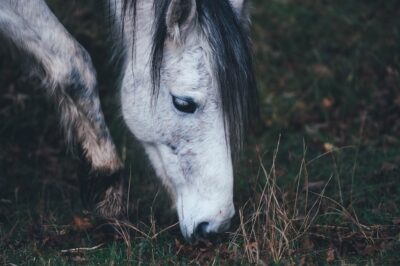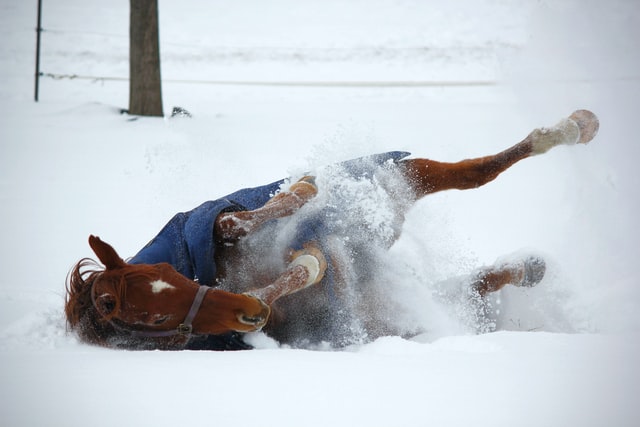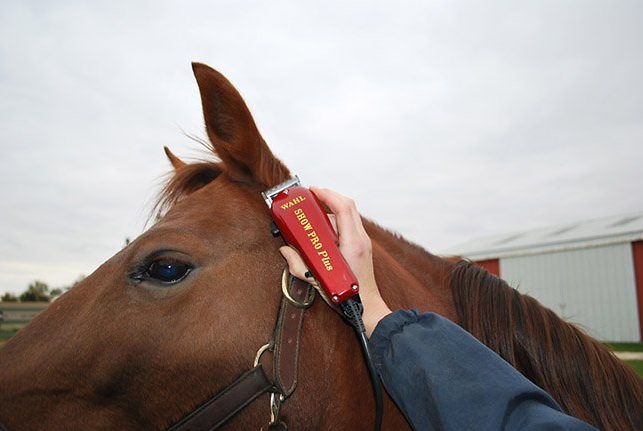Caring For Horses in Winter
Shorter days and colder weather can be difficult on both horses and horse owners.
While we don extra layers, there are unique challenges for caring for horses in Winter.
Begin by having a checklist for horse care in the winter and cold weather.
While some things may be obvious, like blanketing your horse, there are other tasks we need to look at to ensure our horse is safe and comfortable during the winter months.

Caring For Horses in Winter
1. Shelter
Whether your horse is stabled or turned out 24/7, having adequate shelter to protect them from freezing wind and rain is essential.
Not all horses will use a shelter if provided, but one should always be provided so they can choose whether to use it or not.
These shelters don’t need to be heated.
In fact, going from a heated area to freezing weather outside often can lead to chill.
Your run-in shelters or appreciate shelter should be positioned to have their backs towards the prevailing winds to provide the best protection from the wind.
2. Feed
Obviously your horse needs feed all year long, but there are special considerations when feeding your horse in the Winter.
As the temperature drops, the natural grasses you’ll have in your paddock are no longer growing and no longer supplying adequate nutrition.
To replace your horse’s diet, you have to supply hay.
Especially with older horses we need to keep an eye on their body weight.
For help measuring your horse’s weight check out my post.
Horses will usually eat 1-2% of their body weight in forage, both grass and/or hay.
For hay, this can mean 15-20 pounds of hay per day.
It’s a good idea to provide free choice hay, meaning as much good quality hay as they could possibly water, to prevent weight loss.
In addition to providing nutrition, the bacterial fermentation that your horse’s hind end does while processing forages, like hay, actually produces heat as a biproduct, helping to increase their body temperature from the inside-out!
Also consider providing salt blocks and mineral supplement as your horse’s hay often does not contain enough salt and minerals that grass does.
3. Watering Your Horse in the Winter
Depending on your stabling situation, getting fresh, not-frozen water to your horses 24/7 may become tricky.
Just like humans, horses tend to not drink as much water in the Winter as they don’t like drinking cold water when it’s already cold outside.
However, a lack of water consumption can lead to impaction colic, a very serious medical condition.
So plan to provide a source of warm water for your horses.
You can add a heater to your outdoor water troughs or water buckets, but it is essential your horse gets enough water.
I like to provide water buckets so I can keep a closer eye on how much they’re drinking.
The average horse should drink 5-10 gallons of water per day.
In another post we’ll give ideas for how to keep water troughs from freezing.
4. Hoof care
The hoof bears a lot of weight, so it is more prone to injuries and illnesses compared to other parts of the horse’s body.
To maintain a healthy horse, provide proper hoof care as an integral part of your horse care in the winter.
Especially during winter time, their soles bruise easily because of freezing mud.
Use mud control around water troughs and at gates, because muddy hoof-prints that freeze can create hard, uneven ground for your horses to walk in.
Winter often means wetter weather, or more time in stalls. Make sure you pick your horse’s feet once a day to prevent any thrush.
The use of special shoes is common during winter time because these products can safeguard you and your horse from hazards, like snow drifts and slippery trails.
Consult your farrier for ideas.
5. Other Health Concerns
In addition to thrush, wet weather can often cause rain rot and mud fever .
Check out my post on how to prevent and treat rain rot.
One thing to consider in these cold temperatures is blanketing your horse or not.
For the full run down, check out my complete guide to blanketing your horse.
To conserve body heat for thin horses and old horses of if your horse does not have a thick hair coat, you may want to consider blankets.
If your horse will be blanketed, ensure you remove the blanket every few days to check for any rubs, fungus and to check your horse’s body condition score.
Grooming them regularly can prevent many of the skin conditions that are more prone to happen in the Winter.
6. Continued Exercise
Winter time is definitely not a time to hibernate your horse.
Horse care in the winter also includes planning for exercise routines and workouts to keep them fit, strong, and healthy!
A simple exercise, such as easy stretching movements for warm-up, is important.
Some may even just have their horse walk next to them, while others do some extensive workout like indoor jumping & gymnastics.
If you’re going to do extensive exercise with your horse in cold Winter months, you may consider clipping their coat to prevent them from sweating profusely and then possibly getting a chill.
Even a simple trace clip will prevent them getting soaked in sweat and suffering heat loss.
Also consider snow pads if your area gets a lot of snow this time of year.
Caring for horses in Winter involves a little more work than in the Spring or Summer, but you can still enjoy your horse as long as you have the right equipment, feeding plan, shelter, and proper horse care in the winter for them.

Lauren is an internationally published author, trainer, and has helped hundreds of horse-rider combinations create lasting bonds and the success they desire. Check out Lauren’s incredible story: From horse-crazy girl to international equine educator. Or if you want to send Lauren a quick message, check out her contact page here.


